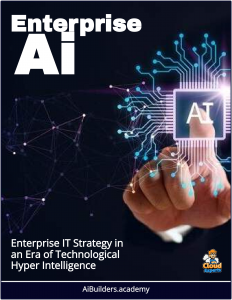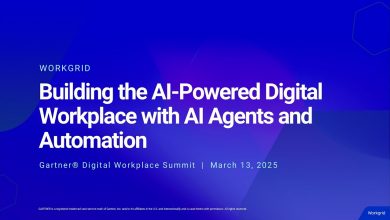AI-Native Enterprises: The Future Of Work With Box CEO Aaron Levie
Levie sees AI-native enterprises as organizations where AI is not just an add-on but a foundational element that enhances productivity, automates repetitive tasks, and enables smarter decision-making.
 Aaron Levie, the CEO of Box, envisions a transformative future for work where AI-native enterprises leverage artificial intelligence to fundamentally reshape how businesses operate, collaborate, and derive value from their data.
Aaron Levie, the CEO of Box, envisions a transformative future for work where AI-native enterprises leverage artificial intelligence to fundamentally reshape how businesses operate, collaborate, and derive value from their data.
His vision centers on the integration of AI, particularly generative AI and large language models (LLMs), into the core of enterprise workflows, with a strong emphasis on unlocking the potential of unstructured data—such as documents, contracts, and multimedia content—that constitutes the majority of corporate information.
Levie sees AI-native enterprises as organizations where AI is not just an add-on but a foundational element that enhances productivity, automates repetitive tasks, and enables smarter decision-making.
Ai Agents
He believes AI will evolve beyond simply providing answers to actively performing tasks, acting as “AI agents” that collaborate with human workers and other AI systems. This shift, he argues, will dramatically change enterprise workflows by allowing businesses to scale intellectual labor and knowledge work at unprecedented levels, especially as AI costs decrease and capabilities improve.
A key pillar of Levie’s vision is the democratization of data access and insights. He highlights how AI can “interrogate” unstructured data—previously a largely untapped resource—enabling employees to ask natural language questions like “How many days of parental leave can I take?” or “Summarize this report with five key takeaways.” This capability transforms enterprise content from static files into dynamic, actionable knowledge, making it far more valuable than traditional storage solutions.
Levie also emphasizes the role of Box as a neutral platform that connects advanced AI models (from providers like OpenAI, Google, and others) to enterprise content securely and compliantly. This neutrality allows Box to adapt to emerging AI breakthroughs, ensuring customers benefit from the latest innovations without being locked into a single ecosystem. He envisions Box evolving from a content management tool into a hub for workflow automation and AI-driven insights, supporting industries like construction, healthcare, and media with use cases such as 3D rendering, contract analysis, and virtual collaboration.
In this future, Levie predicts that AI will not eliminate jobs but rather augment human work, driving companies to achieve more with the same resources. He dismisses notions of reduced workweeks (like a four-day week), suggesting that competitive pressures will push organizations to reinvest productivity gains into innovation and expansion.
For Levie, the AI-native enterprise is about working smarter and faster, with technology handling repetitive tasks while humans focus on creative and strategic endeavors, all underpinned by a digital-first, content-centric approach to business operations.
Enterprise Ai with Box
Box has strategically integrated AI into its services to enhance their power and utility for enterprise customers, focusing on transforming content management into a dynamic, intelligent platform that drives productivity, automation, and actionable insights.
This integration, branded as Box AI, leverages advanced artificial intelligence—particularly generative AI and large language models (LLMs)—to unlock the value of unstructured data, streamline workflows, and ensure secure, compliant operations. Here’s how Box has built AI into its services:
1. Box AI: Intelligent Content Interaction
Box AI is embedded directly into the Box platform, allowing users to interact with their content in natural language. Enterprise customers can ask questions like “What are the key points in this report?” or “Draft a response based on this document,” and Box AI will analyze the content—whether it’s text, PDFs, or other file types—and provide summaries, insights, or generated text. This capability turns static files into a conversational resource, making it easier for employees to extract value without manually sifting through documents.
2. Unstructured Data Processing
Recognizing that 80-90% of enterprise data is unstructured (e.g., contracts, presentations, multimedia), Box has built AI to process and understand this content at scale. For example, Box AI can extract metadata, identify key clauses in legal agreements, or summarize lengthy proposals, all without requiring predefined templates or manual tagging. This enhances searchability and usability, enabling customers to leverage their existing content libraries more effectively.
3. Workflow Automation with Box Relay and AI
Box has enhanced its workflow automation tool, Box Relay, by integrating AI-driven decision-making and content generation. For instance, AI can automatically classify documents, route them to the appropriate teams, or trigger actions based on content analysis (e.g., flagging a contract for legal review if certain terms are detected). This reduces manual steps and accelerates business processes like approvals, onboarding, or compliance checks.
4. Integration with Leading AI Models
Rather than building its own LLMs, Box adopts a “model-agnostic” approach, partnering with top AI providers like OpenAI, Microsoft Azure AI, Google Vertex AI, and Anthropic. This allows Box to plug in the best-performing models for specific tasks—whether it’s text generation, image analysis, or data extraction—and ensures customers benefit from cutting-edge AI advancements. Enterprises can choose models that align with their needs, and Box seamlessly connects these models to their content securely within its platform.
5. Enterprise-Grade Security and Compliance
Box has prioritized embedding AI in a way that meets stringent enterprise requirements. Box AI operates within the Box Trust framework, ensuring data privacy, governance, and compliance with regulations like GDPR, HIPAA, and FedRAMP. Customer data is never used to train external AI models unless explicitly authorized, and all AI interactions occur within Box’s secure cloud environment. This is critical for industries like healthcare, finance, and government, where data sensitivity is paramount.
6. Content Insights and Analytics
Box has enhanced its analytics capabilities with AI-driven Content Insights, which provides deeper visibility into how content is used. AI can identify trends, detect anomalies (e.g., unusual access patterns), or highlight underutilized assets, empowering enterprises to optimize their content strategies. For example, a marketing team could use AI to analyze which campaign assets perform best, based on engagement data.
7. Specialized Use Cases Across Industries
Box tailors its AI capabilities to industry-specific needs. In media, AI can tag and organize video or image assets for faster retrieval. In construction, it can analyze blueprints or project documents to extract timelines and requirements. In legal or financial services, AI assists with contract review, risk assessment, and due diligence by identifying critical terms or discrepancies—all integrated into the Box workflow.
8. Developer Tools with Box AI APIs
For enterprises with custom needs, Box offers APIs and SDKs that allow developers to build AI-powered applications on top of the platform. This enables customers to create bespoke solutions—like integrating Box AI with CRM systems or automating document generation—extending the platform’s power into their unique ecosystems.
Impact for Enterprise Customers
By embedding AI in these ways, Box transforms from a file storage solution into an intelligent content hub.
Customers benefit from faster decision-making (e.g., instant summaries instead of hours of reading), reduced operational friction (e.g., automated workflows), and enhanced collaboration (e.g., AI-drafted responses shared in real time). The scalability of Box AI—offered with unlimited queries in certain plans—ensures enterprises can deploy it broadly without cost barriers, while its secure, neutral architecture makes it a trusted partner for digital transformation.
This AI integration aligns with Aaron Levie’s vision of AI-native enterprises, positioning Box as a leader in enabling businesses to work smarter, not just harder, by harnessing the full potential of their content.



